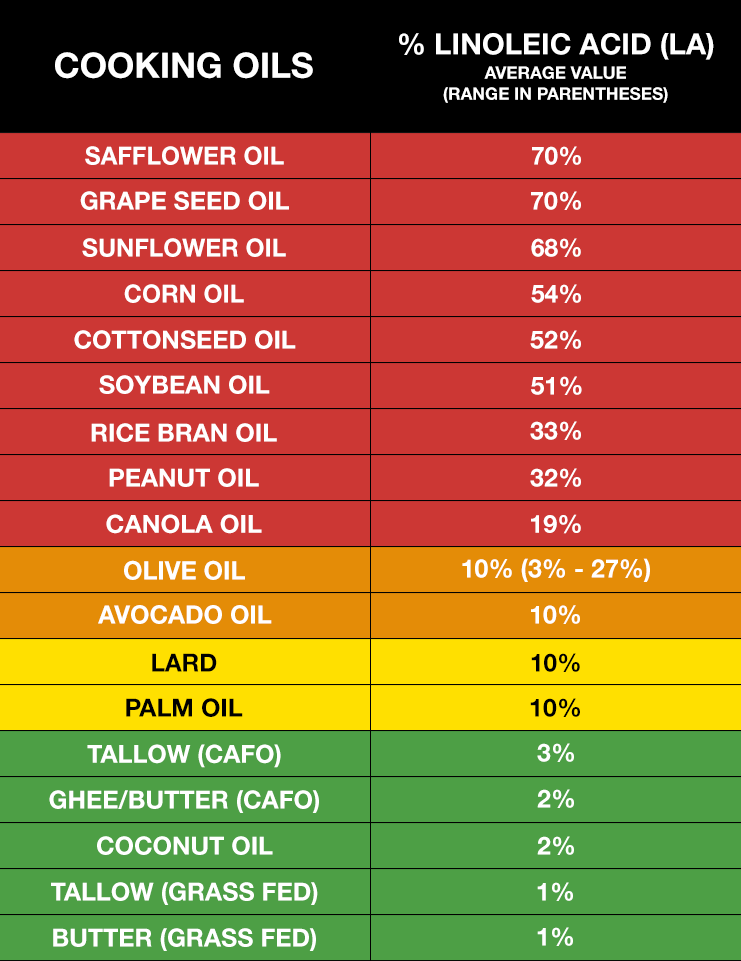Y a-t-il du propane dans votre spray anti-adhésion à l'huile d'avocat ?
https://articles.mercola.com/sites/articles/archive/2023/09/20/propane-avocado-oil-spray.aspx
Is There Propane in Your Nonstick Avocado Oil Spray?

Story at-a-glance
- Most cooking sprays contain an egregious list of ingredients, including dimethyl silicone, an anti-foaming agent that’s also added to paint, textiles and cosmetics
- Propellants, including nitrous oxide, carbon dioxide, n-butane, isobutane and propane, are also added so the oil will spray out of the can
- Additives aside, cooking sprays are made from vegetable and seed oils, such as corn oil, soybean oil, sunflower oil and canola oil
- Seed oils are among the most common sources of linoleic acid in the U.S. diet, excessive levels of which may contribute to cardiovascular disease, cancer, Alzheimer’s and other chronic diseases
- Ditch your toxic cooking sprays in favor of healthier choices; for cooking, excellent substitutions include butter, tallow, ghee and organic coconut oil
Cooking sprays are convenient, but think carefully if savings a few seconds of time is worth risking your health. In addition to harmful additives, the cooking oil itself is toxic, made even worse due to its highly oxidized, aerosolized form.
To add flavor to your food and help keep it from sticking to your pans, use butter, ghee, tallow or coconut oil. These are far superior options to even “healthy” cooking sprays like avocado oil.
Cooking Sprays Contain Additives Like Propane
Most cooking sprays contain an egregious list of ingredients, including dimethyl silicone, an anti-foaming agent that’s also added to paint, textiles and cosmetics.1 The Environment Canada Domestic Substance List classifies this tasteless, colorless chemical as “expected to be toxic or harmful” in terms of organ toxicity and notes “moderate to high toxicity concern in humans” due to its potential to persist or bioaccumulate in the body.2
Soy lecithin, produced after soybean oil is refined, is also often added as an emulsifying agent to keep ingredients from separating. In addition to being “strongly estrogenic” and a potential “major contributor to total estrogenicity,”3 a 1985 animal study suggested soy lecithin may lead to behavioral and neurochemical abnormalities if exposure occurs during pregnancy and early development.4
Propellants are also added so the oil will spray out of the can. Chemicals used for this purpose include nitrous oxide — also known as laughing gas — carbon dioxide, n-butane, isobutane and propane.
Yes, the same propane used for residential heating. While it’s claimed that the propellants leave only a small residue on food that’s within acceptable levels according to the U.S. Food and Drug Administration, propane, an asphyxiating gas,5 is clearly not meant to be consumed.
Most cooking sprays are also made with genetically modified crops, such as soy, corn and canola (rapeseed), bringing with them all the risks of genetically modified organisms (GMOs) and their associated pesticide residues. As noted by The Institute for Responsible Technology:6
“The process of genetic engineering creates mutations and deletions that can happen all throughout the DNA. As a result, allergens can increase if it’s already existing in the food or through the introduction of a new allergen. Same thing with toxins; same thing with carcinogens; same thing with nutrition issues.
And all of that has been found in GMOs, both at the experimental level and also even at the commercial level. GMO corn, for example, has higher levels of existing toxins and a whole new allergen … So the process of genetic engineering is like throwing a dart at our DNA and saying ‘we’ll just turn this one off or turn this one on or make this one higher,’ disregarding the collateral damage.”
Seed Oils in Cooking Sprays Are Toxic
You can get around some of the problems with commercial cooking sprays by purchasing an oil sprayer and adding your own high-quality oil at home. But while this helps you avoid the undesirable additives in cooking sprays, there’s still the issues with the oils themselves. Most are highly toxic due to the linoleic acid (LA) they contain.
My peer-reviewed paper on the hazards of LA, an omega-6 polyunsaturated fat (PUFA), is now published in the high-impact nutrition journal Nutrients and can be downloaded for free.7 Vegetable and seed oils, such as corn oil, soybean oil, sunflower oil and canola oil, are the most common source of PUFAs in the modern human diet.
While LA is an essential fatty acid, when too much is consumed it becomes a precursor to oxidized LA metabolites (OXLAMs), such as 4-Hydroxynonenal (HNE), 9- and 13-hydroxy-octadecadienoic acid (9- and 13-HODE), and 9- and 13-oxo-octadecadienoic acid (9- and 13-oxoODE), which are associated with cardiovascular disease, cancer, Alzheimer’s and other chronic diseases.
Excessive levels of LA may also lead to impairments in mitochondrial function. Because the half-life of LA is about two years, the damage it causes is persistent and may not resolve for years after you’ve dramatically cut back on your LA intake.

Download this Article Before it Disappears
Download PDFYou Probably Consume Far Too Much LA
While it’s important to be aware that cooking sprays are a source of LA, they probably represent only a small contribution to your overall LA intake. This is because the majority of ultraprocessed foods contain one or more industrially processed seed oils. This includes foods like bread, potato chips, cookies and pastries, as well as take-out foods and most restaurant foods.
Globally, 200 million tons of seed oils are consumed every year, and this is expected to rise to 258.4 million tons by 2026.8 This represents a fundamental change in humans’ diets. Even as late as the mid-1900s, 99% of added fats in the human diet came from animal foods. By 2005, seed oils took over, accounting for 86% of added fats.
The result is a significant increase in LA intake, which made up less than 2% of total daily caloric intake before the 20th century — on par with the optimal range of 1% to 2%.9 Currently, the average person’s LA intake makes up more than 25% of their total calorie intake. As I wrote in Nutrients, along with my co-author Chris D'Adamo, Ph.D.:10
“The consumption of LA at these levels lowers the metabolic rate and increases tissue oxidative damage that increases susceptibility to chronic diseases. Consistently elevated LA intake likely accelerates the biological clock, resulting in premature aging and death.
Historically, LA intake increased from approximately 2 g/day in 1865 to 5 g/day in 1909, followed by 18 g/day in 1999, and more recently up to 29 g/day in 2008. LA consumption accounted for approximately just 1/100th (1%) of the total caloric intake in 1865, with an observed increase of more than one-fourth of the total calories by 2010, reflecting a 25-fold increase.”
Why Lard and Olive Oil Aren’t the Best Choices
If cooking sprays and most oils found in grocery stores aren’t good for you, then what should you use for cooking and baking? While olive oil and avocado oil are both considered healthy by mainstream standards, most of these oils are adulterated with cheap seed oils and/or have gone rancid.
It’s very difficult to find really high-quality, fresh, unadulterated olive and avocado oil. For example, a 2020 Food Control report11 found a vast majority of commercially available avocado oils labeled “extra virgin” and “refined” were, in fact, adulterated and of poor quality; 82% had gone rancid before their expiration date.12
Olive oil is typically no better. Tests show that 60% to 90% of olive oil sold in U.S. grocery stores and used in restaurants is adulterated with cheap, oxidized, omega-6 vegetable oils, such as sunflower oil or peanut oil, or nonhuman-grade olive oils, which are harmful to health in a number of ways.13
But even if you do find a good brand, I recommend limiting olive oil and avocado oil to 1 tablespoon a day, as they can be high in LA. The total amount varies from brand to brand. In the case of olive oil, it could be as low as 3% or as high as 25%, depending on the type of olives used. Your best bet is to simply assume there’s LA in there and limit the amount you use each day.
Lard used to be fine, but since the majority of commercial hogs have been fed grains for the last five decades, most lard is now relatively high in LA. If you do choose to use lard, make sure it’s from organically raised animals. For cooking, excellent substitutions include butter, tallow, ghee and organic coconut oil.
Butter and beef tallow have the added benefit of providing the fat-soluble vitamins, A, D and K2. The table below provides a fairly comprehensive list of the most commonly consumed oils and their approximate LA content, helping you see how they stack up for your health.14,15,16

How to Cut Back on LA in Your Diet
As a general rule, try to keep your LA intake under 10 grams a day. Anything more than this is likely to cause problems. The lower the better, however. A reasonable goal for most people is to get your level below 5 grams per day. So, how do you cut seed oils out of your diet? Top culprits to minimize or eliminate include:
Vegetable oils or seed oils used in cooking and cooking sprays |
Processed foods, especially sauces, dressings and other condiments |
All restaurant foods (not just fast food), as most serve food cooked in seed oil, not butter |
Conventionally raised chicken and pork, as both are high in LA due to being fed omega-6 grains (chicken eggs are OK, as each has less than 1 gram of LA) |
Most seeds and nuts, as most, with the exception of macadamia nuts, are loaded with LA |
Bread and other grain products |
What should you eat? As mentioned, replace your seed oils and seed oil cooking sprays with butter, tallow, ghee and organic coconut oil. Chicken eggs are acceptable, as each egg has less than 1 gram of LA. Ruminant animals such as cows, buffalo, sheep, lamb, goats, deer, elk and many other game animals also have low LA content in their milk and meat, no matter what they eat.
This is because they have multiple stomachs with bacteria that can convert the high-LA fat they eat into saturated and monounsaturated fats. So, your best option is to get most of your animal protein from ruminants and avoid or limit chicken and pork. My favorite meats are bison and lamb.
Carnosine May Help Reduce LA-Induced Damage
As you cut back on LA in your diet, that stored in your body will gradually be eliminated. You may be able to support this process, however, using a peptide supplement called carnosine. Carnosine is a dipeptide composed of two amino acids: beta-alanine and histidine. It's a potent antioxidant, the highest concentrations of which are found in your muscles and brain.
Carnosine serves as a sacrificial sink for reactive oxygen species (ROS) and advanced lipoxidation endproducts (ALEs), meaning it lets these very damaging molecules destroy it rather than your mitochondria, DNA or proteins.17 Carnosine itself is not very useful as a supplement as it is rapidly broken down into its constituent amino acids by certain enzymes. Your body then reformulates those amino acids back to carnosine in your muscles.
A more efficient alternative is to supplement with beta-alanine, which appears to be the rate limiting amino acid in the formation of carnosine. Eating beef is known to efficiently raise carnosine levels in your muscle,18 which is why if you’re a vegetarian or vegan this supplement may be particularly important. However, anyone who’s been consuming excessive levels of LA from seed oils and cooking sprays may benefit.

Commentaires
Enregistrer un commentaire